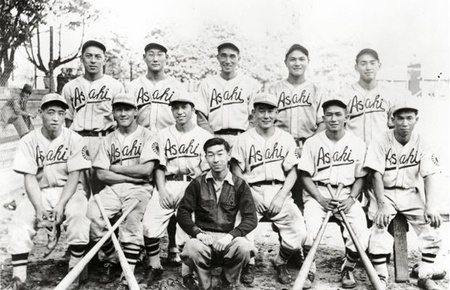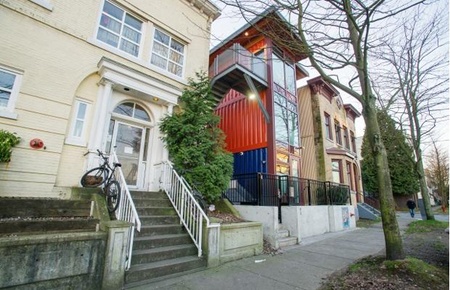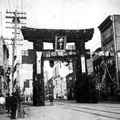Read part 1 >>
Few people realize it, but the city of Vancouver began in Japantown, not Gastown.
The Hastings Mill was located on the waterfront at the foot of Dunlevy in 1865. Some of the workers lived in float houses, others built small shacks on Hastings Road, the original name of today’s Alexander Street. Gastown grew up around Gassy Jack Deighton’s saloon, which popped up in the late 1860s at today’s Carrall and Water.
In the 1880s, Alexander Street was a tony residential street. Hastings Mill manager Richard Alexander—after whom the street is named—built a handsome house with a mansard roof at 300 Alexander. One of his neighbours was Henry Bell-Irving, whose Anglo-British Columbia Packing Company dominated the fish cannery business.
The bluebloods moved out within a few years.
In the 1907 Henderson’s City of Vancouver Directory, the listing for 300 Alexander reads “Japanese boarding house.”
Japanese immigrants had been in the neighbourhood since its beginning.
“The first Japanese arrived in Vancouver in 1877,” said Beth Carter of the Nikkei National Museum and Cultural Centre in Burnaby. “The first (arrivals) were working in fishing, then they went into the mills shortly after that.”
Many early directory listings for Japanese residents don’t record their names, they’re just marked down as “Japanese.” The Japanese community started to reach a critical mass in the neighbourhood in the early 1900s. The commercial buildings were on Powell and Main, the residences were on Alexander and Cordova. It even had its own park, the Powell Street Grounds (Oppenheimer Park), home to the legendary Asahi baseball team.

Last Vancouver Asahi team, 1941. Photo: Columbia Studio, courtesy of Reggie Yasui. Photograph by Handout, PNG
“It was never called Japantown; sometimes it was referred to as Little Tokyo,” said Carter. “In the community it was referred to as Pauearu-Gai, basically Powell Street.”
There were continual problems with racist whites. On September 7, 1907, a meeting of the Oriental Exclusion League at Vancouver’s city hall turned into an anti-Asian riot.
In Japantown, the white rioters fought a fierce hand-to-hand battle with Japanese-Canadians.
“The police on the scene were utterly unable to cope with the mass of struggling, cursing, shouting (rioters who) surged back and forth under the glare of the street arc lights,” reported the Daily Province newspaper. “Armed with sticks, clubs, iron bars, revolvers, knives, and broken glass bottles, the enraged (Japanese) poured forth into the streets as soon as the limit of their patience had been reached.
“Armed with only stones, the mob could not stand before the onslaught of knives and broken bottles propelled by the Japanese while they made the air ring with ‘banzais.’ Many of the Japanese went to the ground as stones thumped against their heads, but the insensible ones were carried off by friends, and the fight kept up till the mob wavered, broke, and finally retreated.”
* * * * *
Japantown recovered from the riot to become a bustling neighbourhood.
“Lots of activity, lots of businesses spilling out onto the street, like vegetable vendors,” says Carter. “The people prided themselves on getting it spotlessly clean. People remember their parents out sweeping the sidewalks every morning, washing them down.”
“It was an incredibly vibrant place in the sense that all the infrastructure was there,” says Grace Eiko Thomson, 80, who grew up at 510 Alexander.
“It was a ghetto. It was there for people to support each other, find work for each other, people like my parents. My mother particularly, who had no English. It was a place where she didn’t need to worry about that, because there was everything there.
“It was very sad when it just died. When Japanese-Canadians left, the place was totally abandoned.”
Japantown died after Japan bombed Pearl Harbor. Canada went to war with Japan, and anti-Japanese sentiment swelled. In February 1942, Japanese-Canadians were ordered to leave the coast.
Jordan Stranger-Ross, a historian at the University of Victoria, says initially the federal government “indicated quite explicitly that property of Japanese-Canadians uprooted from the coast would be protected in the interest of the owners.”
But the city of Vancouver considered Powell Street a slum. Stranger-Ross says a committee was formed by the city “to investigate the quality of housing of Japanese-Canadians, particularly in the Powell Street neighbourhood.”
City departments began to condemn Japanese-Canadian housing and raise concerns about “the prospects of that property being rented to white tenants.”
Alderman George Buscombe upped the ante in 1942, asking the federal custodian of the Japanese-Canadian property, “Can’t you just liquidate all these properties, the way you liquidated (the Japanese-Canadian) fishing vessels?”
The federal government eventually agreed, and sold off all Japanese-Canadian property, save for the Japanese Hall on Alexander Street.
When Japanese-Canadians were allowed to come back to the coast in 1949, few returned to Japantown.
“In 1946, when they were leaving the internment camps, they were given the (option) of going east of the Rockies, or going to Japan,” explains Carter. “About 4,000 people went to Japan, and the rest went east of the Rockies. They went, they settled, they had to basically start from scratch in 1946 in Ontario or various communities.
“Over the next three years they got settled and started to build a life again. (When) in 1949 or ’50 they were allowed to come back, many chose not to. It was too much work to pick up and relocate back again to the coast.”
* * * * *
The area languished, and became somewhat notorious.
“Most people are too afraid to come down to this part of the world, because of the kind of people that are around,” says Richard Turner, an artist who has lived in the neighbourhood for decades. “There are all sorts of people that are in trouble around here.”
But Turner said Japantown is a good place to live. And the high ceilings and open spaces in the area’s many old buildings are great for artists such as himself, who often live and work in the area’s old storefronts.
“You can have a place you can make a mess in, that you don’t have to pay an arm and a leg for,” he said.
“What’s available, in new places? Nothing. It’s always been the case in Vancouver that artists are looking for places that no one else wants, and that have enough room to make a mess in, and set up. That’s just the way it is for artists. It’s not an easy life.”
Since the 1970s the area has been earmarked for social housing by the city. Many of Vancouver’s oldest houses have been torn down for social housing projects, such as an 1888 house at 502 Alexander that was demolished in 2012. It was replaced by housing fashioned from shipping containers.

A new social housing project made out of converted shipping containers at 502 Alexander is flanked by old buildings from Vancouver historic Japantown. Photograph by Arlen Redekop, Vancouver Sun
A few gems remain. The 1889 house at 414 Alexander is arguably the prettiest old Victorian home in Vancouver. But you have to look at a photo in the Vancouver Archives to see it in its 1890s glory—today it’s covered in green asbestos siding.
The city’s McNaney said the city is about to begin an extensive upgrade of its heritage register, which was compiled in the mid-1980s.
“We’re looking at extending the heritage building and facade grants to that area, to protect the heritage buildings,” he said. “So it will be a combination of managed change, since it is an area that is primarily renters, and city incentives to protect the heritage buildings.”
Still, it’s hard to understand how such an important historic neighbourhood was largely ignored when the original register was compiled.
“I think unfortunately it comes down to neighbourhoods like Shaughnessy look like heritage, and slightly depressed Downtown Eastside neighbourhoods don’t look like heritage,” said Vancouver historian John Atkin. “Gastown has its history, and Chinatown looks like heritage, and Japantown generally…doesn’t.”
Grace Eiko Thomson hopes some buildings can be saved.
“Before 1942 there was an active Japanese-Canadian community, there was a town there,” she said. “If you have no trace of it, the area disappears.”
*This article was originally published in the Vancouver Sun on February 8, 2014.
© 2014 John Mackie



